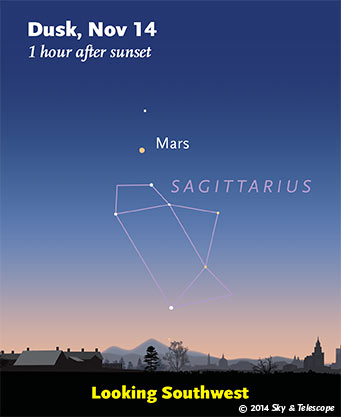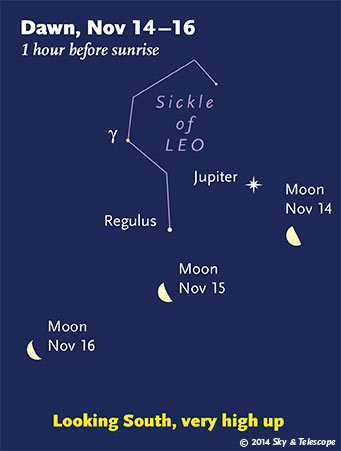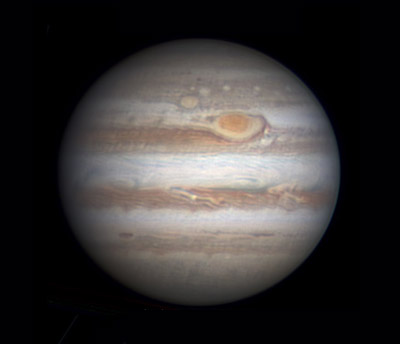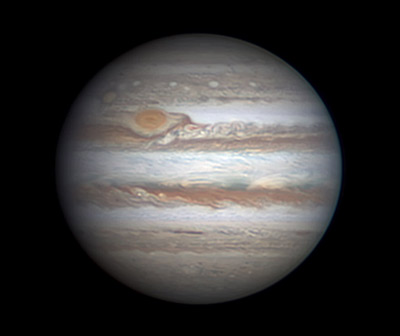Some daily sky sights among the ever-changing Moon, planets, and stars.


Friday, November 14
Keep an eye on little Mars in the southwest at dusk. It will keep hanging in there month after month through this winter, as constellations of the zodiac slide behind it.
Last-quarter Moon (exact at 10:16 a.m. EST). The Moon rises around midnight tonight with Jupiter to its left (for North America.) By dawn Saturday morning the 15th, the Moon is below Regulus with Jupiter now high to their upper right, as shown below.
Saturday, November 15
By about 8 p.m. Orion is clearing the eastern horizon (depending on how far east or west you live in your time zone). High above Orion shines orange Aldebaran. Above Aldebaran is the little Pleiades cluster, the size of your fingertip at arm's length. Far left of the Pleiades shines bright Capella.
Sunday, November 16
By 8 p.m. now, Great Square of Pegasus stands in its level position very high toward the south. Its right side points far down toward Fomalhaut. Its left side points less far down more or less toward Beta Ceti.
If you have an open view to a dark south horizon, and if you're no farther north than roughly New York or Denver, picture an equilateral triangle with Fomalhaut and Beta Ceti forming its top two corners. Near where the third corner would be is Alpha Phoenicis, or Ankaa, in the southern constellation Phoenix. It's magnitude 2.4, not very bright but the brightest thing in the area. Have you ever seen a star of Phoenix before?
Monday, November 17
The Leonid meteor shower should peak late tonight, but don't expect much. Even under ideal dark-sky conditions, you might see roughly a dozen per hour during the best viewing period: from about 1 a.m. Tuesday morning (your local time) until the beginning of dawn. The shower's radiant is in the Sickle of Leo near Jupiter. Also, keep an eye out for the very occasional Taurid fireball. For more: See November's Speedy Leonids.
Tuesday, November 18
Very high now in the north, in the fall Milky Way, is dim Cepheus: husband in myth to brighter Cassiopeia. Its constellation pattern includes two landmark variable stars, Delta (δ) and Mu (μ) Cephei, for binoculars or even the naked eye. Delta is the prototype Cepheid. Mu, "Herschel's Garnet Star," is one of the largest stars known. See Gary Seronik's Binocular Highlight column and chart in the November Sky & Telescope, page 45.
Wednesday, November 19
It's still Summer Triangle season. The Triangle's brightest star is Vega, still well up in the west-northwest after dinnertime. The brightest above Vega is Deneb. The Triangle's third star, Altair, is farther to Vega's left.
Thursday, November 20
Whenever Fomalhaut is "southing" (crossing the meridian due south, which it does around 7 p.m. this week), you know that the first stars of Orion are just about to rise in the east, and the Pointers of the Big Dipper stand directly below Polaris (if you're in the world's mid-northern latitudes).
Friday, November 21
Does it seem like night is already falling about as early as it ever will? You're right! We're still a whole month from the winter solstice (in the Northern Hemisphere), but the Sun sets earliest around December 7th, and right now it sets within about 5 minutes from that time (if you're near latitude 40° north). A surprising result: The Sun actually sets earlier on Thanksgiving than on Christmas near the solstice!
This odd offset is made up for by the opposite happening at sunrise: the Sun comes up latest for the year on January 7th.
Saturday, November 22
High in the northeast, the W pattern of Cassiopeia stands on end as early as 6 p.m. now. Whenever this happens, the dim handle of the Little Dipper (far lower left of Cassiopeia) extends straight left from Polaris.
Algol in Perseus should be at its minimum brightness, magnitude 3.4 instead of its usual 2.1, for two hours centered on 11:50 p.m. EST (8:50 p.m. PST). Algol takes several hours to fade before and to rebrighten after.
________________________________
Want to become a better astronomer? Learn your way around the constellations. They're the key to locating everything fainter and deeper to hunt with binoculars or a telescope.
This is an outdoor nature hobby; for an easy-to-use constellation guide covering the whole evening sky, use the big monthly map in the center of each issue of Sky & Telescope, the essential guide to astronomy. Or download our free Getting Started in Astronomy booklet (which only has bimonthly maps).

Once you get a telescope, to put it to good use you'll need a detailed, large-scale sky atlas (set of charts). The standards are the little Pocket Sky Atlas, which shows stars to magnitude 7.6; the larger and deeper Sky Atlas 2000.0 (stars to magnitude 8.5); and once you know your way around, the even larger Uranometria 2000.0 (stars to magnitude 9.75). And read how to use sky charts with a telescope.
You'll also want a good deep-sky guidebook, such as Sue French's Deep-Sky Wonders collection (which includes its own charts), Sky Atlas 2000.0 Companion by Strong and Sinnott, the bigger Night Sky Observer's Guide by Kepple and Sanner, or the beloved if dated Burnham's Celestial Handbook.
Can a computerized telescope replace charts? Not for beginners, I don't think, and not on mounts and tripods that are less than top-quality mechanically (able to point with better than 0.2° repeatability, which means fairly heavy and expensive). As Terence Dickinson and Alan Dyer say in their Backyard Astronomer's Guide, "A full appreciation of the universe cannot come without developing the skills to find things in the sky and understanding how the sky works. This knowledge comes only by spending time under the stars with star maps in hand."
This Week's Planet Roundup


Mercury (still magnitude –0.8) is sinking away low into the sunrise. Early in the week, look for it a little above the east-southeast horizon about 30 minutes before sunrise. Bring binoculars. Don't confuse it with fainter Spica increasingly far to its upper right, or with Arcturus farther to its upper left.
Venus is hidden deep the glow on sunset.
Mars (magnitude 1.0) remains in the southwest during and after twilight. It sets around 8 p.m. local time.
Jupiter (magnitude –2.1, in western Leo) rises in the east-northeast around 11 p.m. About 40 minutes later, Regulus (magnitude +1.4) rises below it. By dawn they shine high in the south, with Regulus now to Jupiter's left.
Saturn is hidden behind the glare of the Sun.
Uranus (magnitude 5.7, in Pisces) and Neptune (magnitude 7.9, in Aquarius) are high in the southeast and south, respectively, right after dark. They move westward as the evening progresses. Use our finder charts for Uranus and Neptune.
__________________________
All descriptions that relate to your horizon — including the words up, down, right, and left — are written for the world's mid-northern latitudes. Descriptions that also depend on longitude (mainly Moon positions) are for North America.
Eastern Standard Time (EST) is Universal Time (UT, UTC, or GMT) minus 5 hours.
"I do not know what I may appear to the world; but to myself I seem to have been only like a boy playing on the seashore, and diverting myself in now and then finding a smoother pebble or a prettier shell than ordinary, whilst the great ocean of truth lay all undiscovered before me."
— Isaac Newton, 1642–1727
(From the Memoirs of the Life, Writings, and Discoveries of Sir Isaac Newton, David Brewster, 1855)
 2
2
Comments
November 15, 2014 at 5:34 pm
Im looking east around 1am,I can see the bottom half of the moon. What is the object about 8 inches above it???
You must be logged in to post a comment.
mary beth
November 19, 2014 at 1:00 am
I think you might be referring to Regulus. Above it is Jupiter. I need to look tonight, it's been cloudy here for awhile but clear tonight :)! Happy stargazing!
You must be logged in to post a comment.
You must be logged in to post a comment.